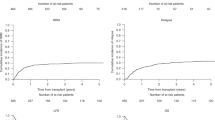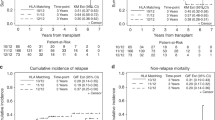Abstract
The effect on survival of including HLA-DPB1 in a 12-allele matching strategy was retrospectively evaluated in 130 patients with acute leukaemia and myelodysplasia undergoing T-cell-depleted PBSC transplantation using unrelated donors. Patients received alemtuzumab in vivo T-cell depletion as part of a myeloablative (MA; n=61) or reduced-intensity conditioning regimen (n=69). No difference in OS was seen with single-locus mismatching (mm) when 10 conventional alleles (HLA-A, B, C, DRB1 and DQB1) were considered. However, the addition of HLA-DPB1 matching data proved highly discriminatory. Mismatches were identified in 87% of patients previously considered fully matched (1DPmm=49pts: 2DPmm=28pts), and in the 9/10 group 22 patients were reclassified as double and 16 as triple mismatches. In 10/10 transplants, there was a distinct trend to poorer OS with double DPB1 mm. If all 12 loci were considered, 98% of single mm were at HLA-DPB1. Furthermore, cumulative mm at two or more loci was associated with significantly poorer 3-year OS (34% vs 48%, P=0.013: hazard ratio 1.8 (95% confidence interval 1.14–3.06; P=0.017), although his detrimental effect was only apparent using MA conditioning, in which reduced OS was associated with increased chronic GVHD (61% vs 16%, P=0.018) and nonrelapse mortality (30% vs 9%, P=0.039).
This is a preview of subscription content, access via your institution
Access options
Subscribe to this journal
Receive 12 print issues and online access
$259.00 per year
only $21.58 per issue
Buy this article
- Purchase on Springer Link
- Instant access to full article PDF
Prices may be subject to local taxes which are calculated during checkout



Similar content being viewed by others
References
Lee SJ, Klein J, Haagenson M, Baxter-Lowe LA, Confer DL, Eapen M et al. High-resolution donor-recipient HLA matching contributes to the success of unrelated donor marrow transplantation. Blood 2007; 110: 4576–4583.
Loiseau P, Busson M, Balere ML, Dormoy A, Bignon JD, Gagne K et al. HLA Association with hematopoietic stem cell transplantation outcome: the number of mismatches at HLA-A, -B, -C, -DRB1, or -DQB1 is strongly associated with overall survival. Biol Blood Marrow Transplant 2007; 13: 965–974.
Mead AJ, Thomson KJ, Morris EC, Mohamedbhai S, Denovan S, Orti G et al. HLA-mismatched unrelated donors are a viable alternate graft source for allogeneic transplantation following alemtuzumab-based reduced-intensity conditioning. Blood 2010; 115: 5147–5153.
Shaw BE, Mayor NP, Russell NH, Apperley JF, Clark RE, Cornish J et al. Diverging effects of HLA-DPB1 matching status on outcome following unrelated donor transplantation depending on disease stage and the degree of matching for other HLA alleles. Leukemia 2010; 24: 58–65.
Robinson J, Halliwell JA, McWilliam H, Lopez R, Parham P, Marsh SG . The IMGT/HLA database. Nucleic Acids Res 2013; 41 (Database issue): D1222–D1227.
Begovich AB, McClure GR, Suraj VC, Helmuth RC, Fildes N, Bugawan TL et al. Polymorphism, recombination, and linkage disequilibrium within the HLA class II region. J Immunol 1992; 148: 249–258.
Nomura N, Ota M, Kato S, Inoko H, Tsuji K . Severe acute graft-versus-host disease by HLA-DPB1 disparity in recombinant family of bone marrow transplantation between serologically HLA-identical siblings: an application of the polymerase chain reaction-restriction fragment length polymorphism method. Hum Immunol 1991; 32: 261–268.
Gallardo D, Brunet S, Torres A, Alonso-Nieto M, Vallejo C, Jimenez A et al. Hla-DPB1 mismatch in HLA-A-B-DRB1 identical sibling donor stem cell transplantation and acute graft-versus-host disease. Transplantation 2004; 77: 1107–1110.
Varney MD, Lester S, McCluskey J, Gao X, Tait BD . Matching for HLA DPA1 and DPB1 alleles in unrelated bone marrow transplantation. Hum Immunol 1999; 60: 532–538.
Fleischhauer K, Shaw BE, Gooley T, Malkki M, Bardy P, Bignon JD et al. Effect of T-cell-epitope matching at HLA-DPB1 in recipients of unrelated-donor haemopoietic-cell transplantation: a retrospective study. Lancet Oncol 2012; 13: 366–374.
Shaw BE, Gooley T, Madrigal JA, Malkki M, Marsh SG, Petersdorf EW . Clinical importance of HLA-DPB1 in haematopoietic cell transplantation. Tissue Antigens 2007; 69 (Suppl 1): 36–41.
Shaw BE, Gooley TA, Malkki M, Madrigal JA, Begovich AB, Horowitz MM et al. The importance of HLA-DPB1 in unrelated donor hematopoietic cell transplantation. Blood 2007; 110: 4560–4566.
Shaw BE, Potter MN, Mayor NP, Pay AL, Smith C, Goldman JM et al. The degree of matching at HLA-DPB1 predicts for acute graft-versus-host disease and disease relapse following haematopoietic stem cell transplantation. Bone Marrow Transplant 2003; 31: 1001–1008.
Rutten CE, van Luxemburg-Heijs SA, Halkes CJ, van Bergen CA, Marijt EW, Oudshoorn M et al. Patient HLA-DP-specific CD4+ T cells from HLA-DPB1-mismatched donor lymphocyte infusion can induce graft-versus-leukemia reactivity in the presence or absence of graft-versus-host disease. Biol Blood Marrow Transplant 2013; 19: 40–48.
Petersdorf EW, Gooley T, Malkki M, Anasetti C, Martin P, Woolfrey A et al. The biological significance of HLA-DP gene variation in haematopoietic cell transplantation. Br J Haematol 2001; 112: 988–994.
Loiseau P, Esperou H, Busson M, Sghiri R, Tamouza R, Hilarius M et al. DPB1 disparities contribute to severe GVHD and reduced patient survival after unrelated donor bone marrow transplantation. Bone Marrow Transplant 2002; 30: 497–502.
Gaschet J, Gallot G, Ibisch C, Lim A, Even J, Vivien R et al. Acute graft-versus-host disease after bone marrow transplantation with a single HLA-DPB1*1001 mismatch: involvement of different TCRBV subsets. Bone Marrow Transplant 1998; 22: 385–392.
Ibisch C, Gallot G, Vivien R, Diez E, Jotereau F, Garand R et al. Recognition of leukemic blasts by HLA-DPB1-specific cytotoxic T cell clones: a perspective for adjuvant immunotherapy post-bone marrow transplantation. Bone Marrow Transplant 1999; 23: 1153–1159.
Rutten CE, van Luxemburg-Heijs SA, van der Meijden ED, Griffioen M, Oudshoorn M, Willemze R et al. Both permissive and nonpermissive HLA-DPB1 mismatches can induce polyclonal HLA-DPB1 specific immune responses in vivo and in vitro. Blood 2010; 115: 151–153.
Crocchiolo R, Zino E, Vago L, Oneto R, Bruno B, Pollichieni S et al. Nonpermissive HLA-DPB1 disparity is a significant independent risk factor for mortality after unrelated hematopoietic stem cell transplantation. Blood 2009; 114: 1437–1444.
Zino E, Frumento G, Marktel S, Sormani MP, Ficara F, Di Terlizzi S et al. A T cell epitope encoded by a subset of HLA-DPB1 alleles determines nonpermissive mismatches for hematologic stem cell transplantation. Blood 2004; 103: 1417–1424.
Touzeau C, Gagne K, Sebille V, Herry P, Chevallier P, Follea G et al. Investigation of the impact of HLA-DPB1 matching status in 10/10 HLA matched unrelated hematopoietic stem cell transplantation: results of a French single center study. Hum Immunol 2012; 73: 711–714.
Woolfrey A, Lee SJ, Gooley TA, Malkki M, Martin PJ, Pagel JM et al. HLA-allele matched unrelated donors compared to HLA-matched sibling donors: role of cell source and disease risk category. Bio Blood Marrow Transplant 2010; 16: 1382–1387.
Author information
Authors and Affiliations
Corresponding author
Ethics declarations
Competing interests
The authors declare no conflict of interest.
Rights and permissions
About this article
Cite this article
Burt, C., Parker, A., McQuaker, G. et al. In a 12-allele analysis HLA-DPB1 matching is associated with improved OS in leukaemic and myelodysplastic patients receiving myeloablative T-cell-depleted PBSCT from unrelated donors. Bone Marrow Transplant 49, 657–663 (2014). https://doi.org/10.1038/bmt.2014.8
Received:
Revised:
Accepted:
Published:
Issue Date:
DOI: https://doi.org/10.1038/bmt.2014.8
Keywords
This article is cited by
-
Recipient/donor HLA and CMV matching in recipients of T-cell-depleted unrelated donor haematopoietic cell transplants
Bone Marrow Transplantation (2017)
-
Unrelated donor search prognostic score to support early HLA consultation and clinical decisions
Bone Marrow Transplantation (2016)
-
Is there any impact of HLA-DPB1 disparity in 10/10 HLA-matched unrelated hematopoietic SCT? Results of a French multicentric retrospective study
Bone Marrow Transplantation (2015)



